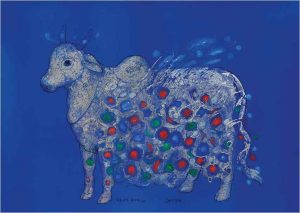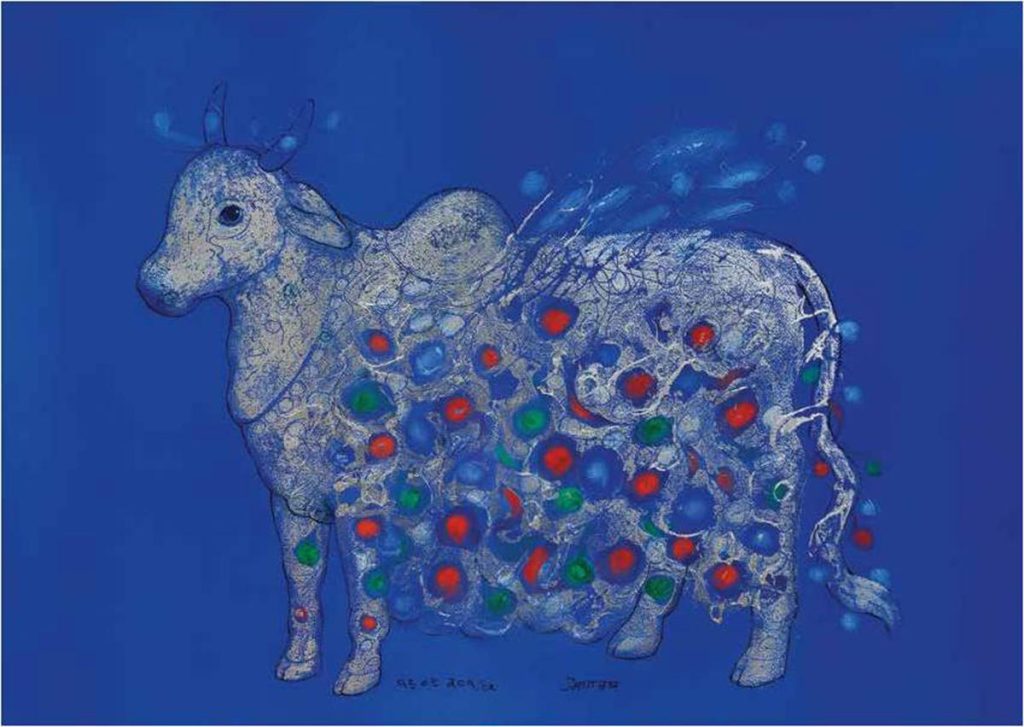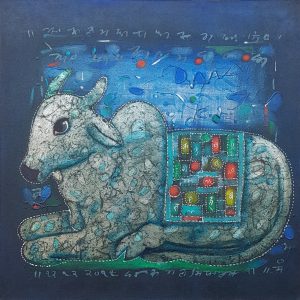Prachi Sahasrabudhe
The cow sits in the middle of the road in Delhi, and foreigners enjoy seeing her since they are unable to imagine cows sitting in the middle of the roadways in their respective countries. They also like the cultural and religious angle, which keeps cows from being chased out of public places, as well as the stereotype of India or Indian streets, where you can see an elephant, a camel, a cow, a donkey, impoverished rickshaw pullers, hand carts, Audis, BMWs, and four wheelers driven by cripples. This is why the country is known as ‘Incredible India’. India’s diverse culture and traditions have always been a major attraction for tourists from all over the world. The coexistence of modernity and tradition is what makes India unique and fascinating to visitors.
Sidharth, Natural Pigments Silver Foil on Canvas, 24-x24 Inches, 2018, https://www.mojarto.com/
However, the cow has become a victim of stereotypes as people have taken over their grazing pastures and replaced them with luxurious residences complete with gardens and greeneries. Vendors offer them bananas, cabbage peels, carrots, cucumbers, and other produce when they go to the local markets. They are forced out of their own grounds, and even if they are given some veggies, they constantly want more. When they haggle with the locals, they steal some vegetables and are rewarded for it. Ironically, the same cow is also harassed by a human who worships her with camphor and coconut. This shows the complexity of human behaviour and how it can vary from person to person. While some may resort to violence, others may show reverence and worship towards the same animal.
In his childhood, Sidharth’s grandma told him a story about a guy who abandoned his castle to save the planet and all living things, including cows. Sidharth’s project ‘The Decorated Cow’ featured paintings, sculptures, photography, and films at the Religare Arts Gallery in New Delhi. The storyteller is prone to gravitating towards the fourth dimension, where surprises lurk, and the fifth dimension, where visuals are only metaphors. The sixth dimension is that the narrative is your actual life, instead of a story. Decorated Cow is a collection of paintings, sculptures, and videos by Sidharth. Sidharth depicts cows in the painting series as mystical, cosmic, lost, maternal, and iconic. Sidharth wants to convert the cows become contemporary symbols by interpolating pictures from their life into sculptures.
Sidharth’s video in the series depicts how rural residents take cows decked with cowry shells and other paraphernalia and make them prophesy the destiny of the believers. Sidharth followed cows for days, encountering several more cows and bulls along the route. Finally, by dusk, they arrived at the Yamuna riverbed, which was not the Yamuna of Lord Krishna, who used to herd his cattle near this river during Gau dhooli time. Gau dhooli is a period in the evening before the sun sets when cattle return to their shelters, kicking up a lot of dust from their hooves all the way back. In some cultures, Gau dhooli is considered a sacred time when people offer prayers and perform rituals to protect their cattle from evil spirits. The dust kicked up by the cattle is also believed to have medicinal properties and is collected for various purposes. Although, Sidharth believes it is a very intense moment of nostalgia, memory, and separation.
Sidharth came across a cow on the banks of the Yamuna River and saw mountains of garbage thrown by the Municipal Corporation of Delhi’s scouring vehicles. He saw the miserable cows eating the plastic and decomposing organic garbage, which was a pitiful sight. He then went to an NGO that worked for the welfare of cows in the city and discovered that most of these cows had been abandoned by their owners and would not be picked up by the authorities. He also discovered that many of the cows die in destitution because they ingest over twenty kilogrammes of plastic garbage, which never gets digested and leads them to acquire some form of suffocation choking them to death. Sidharth realised how horrible it is for humans to idolise and mistreat cows. He investigated cow allusions in Indian myths and elsewhere and discovered that only in India do we both worship and abuse cows. To emphasise this fact, he subdivided the topic into several sections, including cosmic cow, mythological cow, maternal cow, lost cow, and laughing cow. This enabled him to address numerous parts of the common psyche’s perception of a cow.
 Sidharth, https://www.mojarto.com/
Sidharth, https://www.mojarto.com/
Sidharth’s series celebrates the representation of cows, but also critiques how we mistreat them in real life. He uses transcendental elements to vivify the theme, and there is cow-related economics in this country. When a rustic mendicant adopts a cow and takes her around decorated in cowry shells and embroidered clothes, they enter an economy of existence, which has a spiritual and superstitious side to it. In his short film and video, Sidharth shows a decorated cow standing in the middle of a busy street and plays it in a reverse order in which the cow is seen getting decorated and getting stripped in sequence. This continuous play of decorating and stripping highlights the aggression that we do to these poor creatures. The film sheds light on the inhumane treatment of animals and the lack of empathy towards them. It aims to encourage people to be more compassionate towards all living beings.
Sidharth’s Decorated Cow project transforms one image into a new metaphor. He is not a covert feminist, but a humanist who considers art to be his religion. Sidharth glances out the window and sees another cow waiting for the pity of the people. When he was working on the series, he became agitated because he realised, he was telling the story of the earth itself, which has long been choked by plastic. He laughs and says, it is not about activism, but the concern of a human being who has not escaped this world. With this series of works, he intends to raise awareness about the impact of plastic on the environment and inspire people to take action to reduce their plastic consumption. He believes that every individual has a responsibility to protect the planet for future generations.
***
References:
- ML, Johnny, “The circle of Light – Life and times of Siddharth,” Chennai, Prakrit Arts pvt.ltd., p.p. 65 to 70.
- ML, Johnny, ‘By all means necessary,’ July 2011, JohnyML. blogspot.com. • https://www.gallerienvya.com/artist/sidharth/






